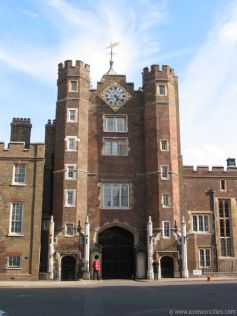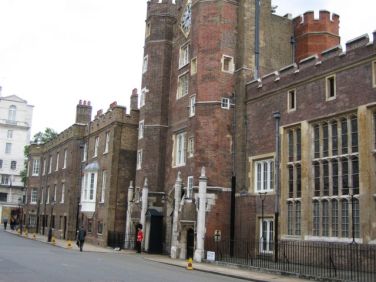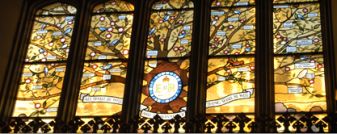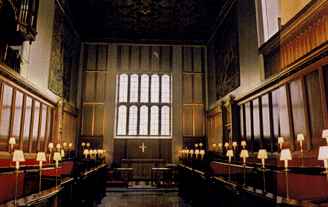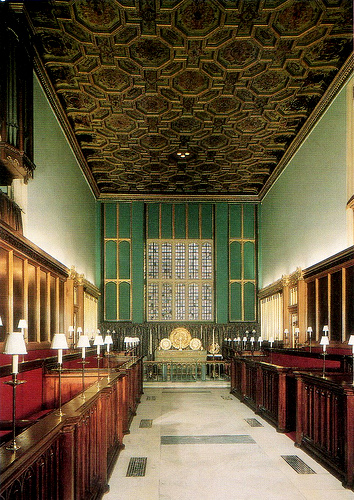St. James Palace
Jump to navigation
Jump to search
| St. James Palace, London Want to add to this page? Click EasyEdit to update this page! (Don't see the EasyEdit button above? <a href="/#signin" target="_self">Sign in</a> or <a href="/accountnew" target="_self">Sign up</a> |
(large pics on left and small pics & text on the right.)
| | Built by King Henry VIII, the palace takes its name from a hospital for leper women that previously existed on the site. With its red brick, clock tower, and Tudor style masonry, St. James is often confused with Hampton Court Palace. Located on Pall Mall where the former leper hospital was located, St. James was commissioned by Henry VIII in 1532 and was completed in 1540. It became the king's secondary residence to Whitehall. Henry Fitzroy lived briefly at St. James and died there in 1536. Anne Boleyn stayed there the night after her coronation, and the "H&A" motif can still be found in various apartments in the palace. Thomas Cromwell, Earl of Essex had use of St. James Palace. It was in St. James that Mary I signed the treaty surrendering Calais to the French. In 1558, Mary I died at St. James and her body laid in state within its chapel royal. It is said that in preparation for her funeral, Mary's heart was removed during embalming and buried in the chapel beneath the choir stalls. Thomas Tallis served as an organist during Elizabeth in chapel royal. It was also here that Elizabeth I said her prayers for the defence of the realm against the threat of the Spanish Armada in 1588, having chosen to remain at St James's Palace to receive messages of its progress by fire beacons from Cornwall |
| The Chapel Royal at St. James's Palace has a long musical history, and is considered to be the cradle of English church music. Among its many noted organists and composers were Thomas Tallis, William Byrd, Orlando Gibbons and Henry Purcell. Purcell lived in a suite of apartments in St James's Palace. The poet Dryden, who was frequently in debt, used to take refuge with Purcell in his apartments in order to avoid the clutches of persistent creditors. One of the Chapel's most notable organists and composers was George Frederick Handel, who was appointed by George II on 25 February 1723 as 'Composer of Musick of His Majesty's Chappel Royal'. The title was constructed to allow Handel, still a German citizen, to contribute to the musical development of the Chapel Royal without actually being a member of it. Handel composed the great anthem 'Zadok the Priest' for the coronation of George II in 1727 and it has been used at every coronation since. It is also sung each year at the Royal Maundy service in which the Queen distributes Maundy money. | |
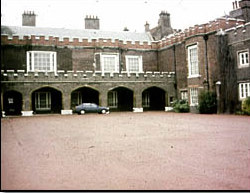 | Charles I received the Holy Sacrament here in 1649, before taking the short walk across the park, to his execution in Whitehall. George III was married at the palace in 1761 and so was his son George IV, just over thirty years later. After 1820, King George IV decided the state apartments were no longer grand enough and he built a new palace on the site of his parent's house that was named Buckingham Palace. Queen Victoria married her beloved Albert, who became the Prince Consort, in the chapel in 1840. St James's Palace continued to be a focal point for royal ceremony and it was here in 1952 that Elizabeth II made her first speech as Queen. |
| It was at Clarence House, in St James's Palace, that Lady Diana Spencer waited before her wedding in 1981. In 1988 Princess Beatrice, the daughter of the Duke and Duchess of York was christened here. In 1997, the coffin of Diana, Princess of Wales lay before the altar where her family and friends could pay their respects in private, before the Princess's funeral in Westminster Abbey. St James's Palace, located only a short distance from Buckingham Palace remains the official home of the Monarchy (as it is officially the Court of St. James) yet is only used for the occasional reception and houses many offices and apartments. | |
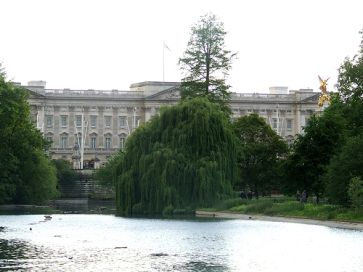 a view from St. James Park | St. James's Palace is still a working palace, and the Royal Court is still formally based here – foreign ambassadors are still accredited to the Court of St. James's, even though they are received by the monarch at Buckingham Palace. It is also the current London residence of Anne, the Princess Royal. |
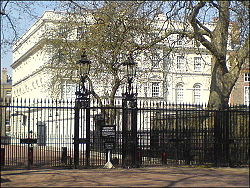 | Clarence House (built between 1825 and 1827) which is attached to St. James and formerly the Royal Residence of The Queen Mother is now the Royal Household of Prince Charles, the Duchess of Cornwall, Prince William and Prince Harry. |
| LINKS: |

